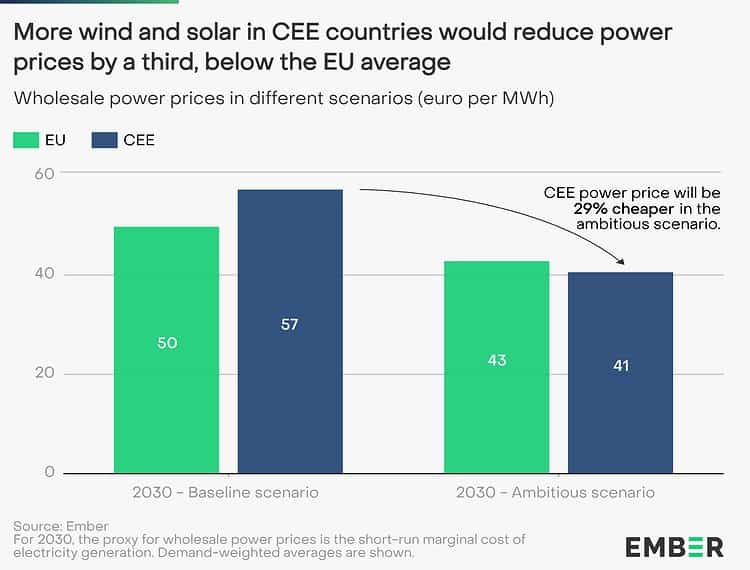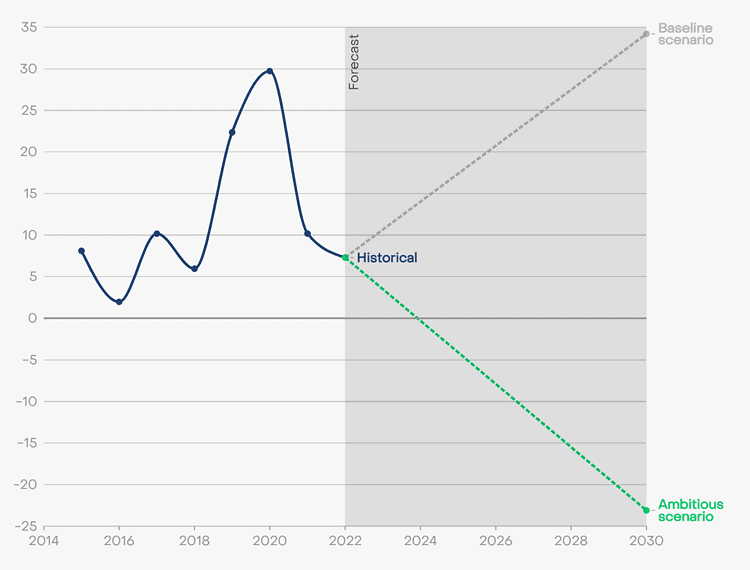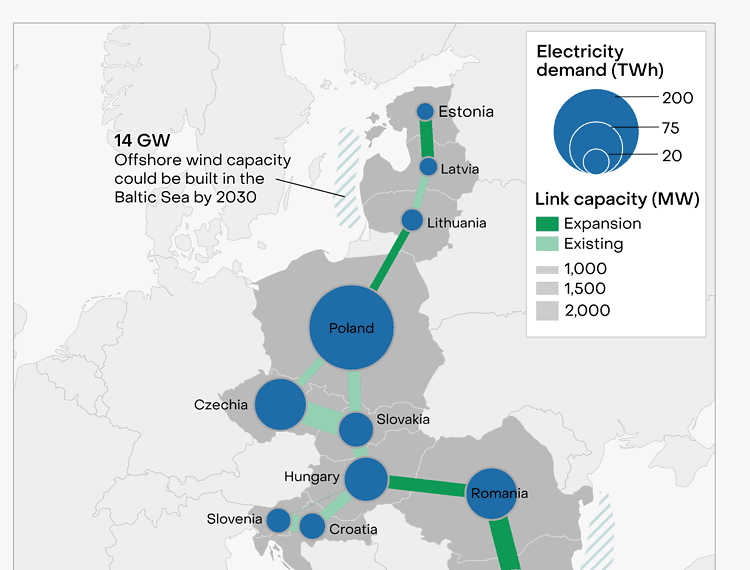With their neighbours queuing up to secure as much cheap, clean power as possible, it is high time governments in central and eastern Europe (CEE) put dirty coal and gas behind them for good. The coming revision of National Energy and Climate Plans, by which European Union member states align themselves with the EU’s 2030 targets in these regards, provides the opportunity. What is needed is a collaborative vision of the region’s power system that will lower the cost of living and provide a lucrative energy surplus.
Evidence that the CEE region could build a significant surplus of low-cost, green electricity, attracting new investments and increasing economic competitiveness, comes in a new report from the think-tank Ember. Thanks to their vast renewables potential, CEE countries—Estonia, Latvia, Lithuania, Poland, Czechia, Slovakia, Hungary, Slovenia, Croatia, Romania and Bulgaria—could increase wind and solar capacity from 35 gigawatts today to 196GW in 2030, resulting in 29 per cent lower average electricity wholesale prices than in a scenario based on current policy conditions.

Changing the trajectory
Pursuit of a more ambitious pathway could change the trajectory of the EU’s effort to decarbonise its power system. The CEE region covers 20 per cent of the union’s population and territory, 15 per cent of its gross domestic product and 17 per cent of electricity demand. But it still accounts for just 7 per cent and 12 per cent of EU wind and solar capacity respectively. Renewables targets in the region are among the lowest in the EU, and most power (55 per cent) still comes from fossil fuels, leading to high electricity prices, import dependence and—especially in the context of the war in Ukraine—security concerns.
According to Ember’s analysis, removing bottlenecks to renewables deployment, such as grid congestion and chaotic spatial planning, could see renewables reach a 63 per cent share of electricity generation in the region by 2030, compared with only 25 per cent today. It would also open access to at least €137 billion in EU grants to invest in the energy transition.
With almost 200GW of wind and solar, CEE could export 23 terawatt-hours of electricity in 2030, compared with importing 7TWh in 2022. Businesses are now on the hunt for this cheap electricity, as are governments. Research shows that the wholesale price decrease thanks to more wind and solar would also translate directly into lower household bills, meaning the whole of society would see the benefits of more ambitious renewables expansion.

Economic benefits
A lot of resources are at stake. Offshore wind potential in the region is estimated at around 100GW, with 20GW available by 2030. Estonia, Latvia and Lithuania alone could produce an energy surplus of around 20TWh by the end of the decade. This is the equivalent of the current power consumption of Czechia’s massive industry sector (18.7TWh) or, even more strikingly, over 70 per cent of Slovakia’s total electricity demand.
The economic benefits across CEE could depend on how this potential generation is distributed. Electricity from offshore wind needs to be transferred from the sea to demand centres. If Poland however implemented the vision of its transmission-system operator of a north-south power bridge, all players involved would benefit. The Baltic states would profit from energy exports, countries such as Czechia, Slovakia and Hungary would gain access to cheap, green electricity for their businesses and Poland could make money facilitating the power transit (replacing corresponding profits lost from gas).
The same logic could be applied across the region, with countries sharing their sun and wind to optimise power supply and lower prices. This may sound utopian but Luxembourg and Finland are already planning a cross-border tender for renewable energy, setting a precedent for cross-country renewables financing. Bulgaria and Romania are discussing a joint energy island, while Latvia and Estonia are co-developing a cross-country offshore wind farm.

Political will
Ember’s research shows this vision of a connected CEE power system is technically possible. Whether there is the political will to make it happen will be determined in the years ahead. Elections are coming in Poland and Slovakia and megaprojects such as a joint CEE power grid would be an attractive way to enhance governments’ platforms.
Estonia already has a 100 per cent renewables target for 2030 and Czechia has a new, progressive president, who could potentially champion an Apollo-scale project such as this, uniting the region around its energy interests. With enough momentum, CEE countries could build a cheaper, cleaner and safer power system, with benefits for their economies and their citizens as well as the planet.
Paweł Czyżak is a senior energy and climate data analyst at Ember, working on scaling up clean energy in Europe. Pawel has several years of experience supporting large companies and NGOs with their economic and data analysis, and is the author of numerous academic and policy publications.

